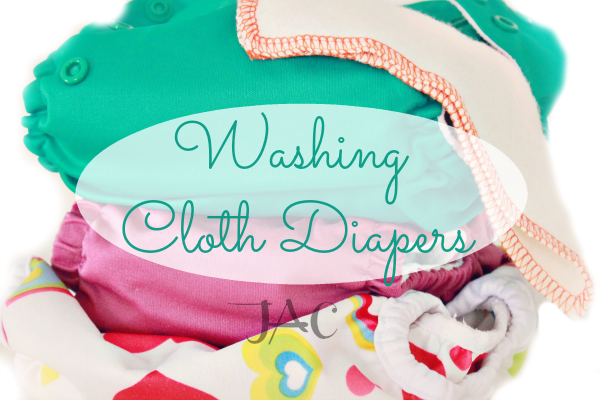
Diaper Care and Washing Instructions
Despite all the information and opinions floating among the cloth diapering community, laundering your diapers doesn’t need to be complicated. The most important ingredients for washing cloth diapers are WATER and a cloth diaper safe detergent.
Most smell and repelling issues are from build up, which you can help prevent by using enough water. Water efficient washing machines means adding a couple extra steps to your wash routine in order to get all of the ammonia and detergent rinsed out.
First and foremost, find a detergent that is free of perfumes, dyes, brighteners, bleach, enzymes, oils, or other fabric enhancers. These can cause residual build up. Brighteners to make fabric look artificially whiter and brighter and perfumes to cover up odor do not equal clean, and will work against you.
Also avoid soaps and fabric softeners as they leave a layer of residue on most surfaces which will cause your diapers to repel liquid causing leaks. This includes dryer sheets. Depending on how hard or soft your water is, it may take a few different detergents and washing routines to find what works for your family.
Do not use diaper rash creams with your cloth diapers unless you use a barrier such as a fleece or flushable liner between the skin and cloth. Creams leave behind a residue that can cause repelling.
Avoid soaking PUL shells or covers for too long. It will cause the PUL to separate. If your shells are stained, simply hang them in the sun to dry. Even in front of a sunny window during the winter works. Even most stubborn stains come out within a few uses and washes.
Solids from exclusively breast fed and formula fed babies are water soluble and therefore no rinsing is necessary before placing them in the washer. Solids from babies eating purees and table foods should be knocked off into the toilet prior to laundering. Some people may prefer to use a diaper sprayer to rinse diapers over the toilet before placing them in the washer. Flushable liners are another option. In general, the only time liners or extensive rinsing is necessary is when baby is transitioning from exclusive breastfeeding to solids. This can cause a sticky texture in the waste making it difficult to remove from the diaper. This phase generally only lasts a few weeks.
General Washing
Your washing routine will depend on the type of washer you have.
Preferably:
-Pre-rinse in cold water to remove any residual solids and excessive urine and ammonia.
-Hot or warm wash (not on sanitize) with a small amount of diaper friendly detergent. If your detergent is meant for cloth diapers, then use the amount directed. For regular detergents, only use 1/4 the amount directed or less. If you have an HE washing machine, only a tablespoon or so is needed. The less detergent, the better.
-Warm rinse
-Followed by another rinse. Preferably cold.
For HE machines, an additional rinse may be needed. If there appear to be any suds at all remaining, your diapers needs another rinse. Some people are able to trick their machines into using more water by putting a wet bath towel in with their diaper load.
-You may dry your diapers in the dryer on low heat. However, this will make the elastic wear out quicker and can damage the PUL layer. Line drying your covers and Pocket diaper shells is preferred. Inserts can go in the dryer on any temp or line dry. If they feel stiff after line drying, placing them in the dryer for 10 minutes can soften and fluff them up. Again, do not use dryer sheets or bars with any of your cloth diapers.
Prepping
Covers only need one wash prior to use in order to rinse off any manufacturing residue.
Pocket shells can be used after one wash.
Inserts, fitteds, and prefolds will need several washes to rinse out natural oils in the fabric to ensure adequate absorbency. This will vary, but many natural fabrics, especially cotton and hemp, will not reach maximum absorbency until 10 washes. It is best to prep hemp and cotton diapers separate from microfiber inserts, but not detrimental. If you are uncomfortable using so much water for prepping, simply add your items to prep to a regular load of laundry and wash the whole load with your diaper safe detergent. Some people prefer to boil their hemp cloth to avoid multiple prepping washes.
Stripping your Diapers
If your diapers or inserts begin repelling liquid, or still smell of ammonia out of the wash, they may have too much detergent buildup. This can be common with hard water, not enough rinsing, or using the wrong detergent.
If your diaper is leaking significantly and the insert remains dry, then it is likely repelling, unless the diaper does not fit properly. If the insert is saturated then you simply need to change the diaper more often or add an extra insert for more absorbency.
Your diapers can be stripped by putting them in a wash tub or bathtub with hot water and a tablespoon of Dawn dish soap. Swish them around and make sure all the inserts and diapers are saturated. Once they have absorbed the water, put them in the washer and run them through with no detergent repeatedly until there are NO suds. This can take quite a few rinses.
Instead of using dish soap soaking, you can also choose to wash your diapers a few times without any detergent and see if the rinse water is sudsy. Repeat until the rinse water runs clear, without suds.
See the Cloth Diaper Reviews page for a bunch of detergent reviews to help with your washing adventures. See also the Cloth diaper FAQs page.


